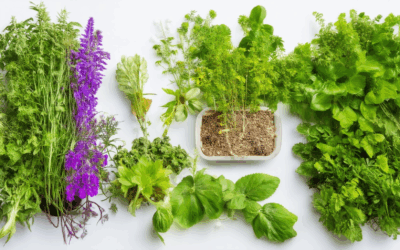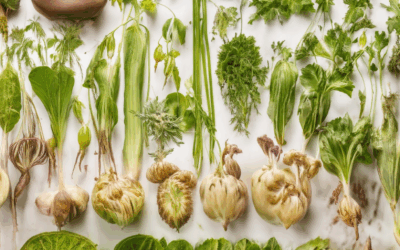Eco-friendly vegetable gardening isn’t just a trend—it’s a necessity. With the growing demand for sustainable living, many gardeners are turning to eco-friendly practices to reduce their environmental footprint while still enjoying fresh, homegrown produce. Whether you’re new to gardening or looking to refine your skills, adopting eco-friendly methods can benefit both your garden and the planet. From reducing chemical use to preserving soil health and conserving water, eco-friendly gardening offers countless advantages. In this guide, we’ll explore tips, tricks, and practices that will help you create a thriving, sustainable vegetable garden. Discover how to choose the right vegetables, select eco-friendly plants, and implement strategies that promote biodiversity and long-term productivity. Whether you’re aiming to grow organic vegetables in pots or establish a larger garden, these sustainable gardening ideas will empower you to make a positive impact on your surroundings. Let’s dive into the world of eco-friendly gardening and unlock the secrets to a greener, healthier garden.
Key Takeaways
– Eco-Friendly Plants: Grow bamboo for rapid growth, minimal chemical inputs, and carbon sequestration. Choose mushrooms for sustainable cultivation and unique benefits. Opt for wheatgrass to prevent soil erosion and reduce water usage. Add aloe vera to your garden for drought resistance and air purification. Comfrey enhances soil health and serves as a natural fertilizer.
– Resilient Plants: Select roses for their ability to thrive in diverse environments. Grow kangaroo paws for drought tolerance and deep root systems. Plant baobab trees for extreme heat resistance and moisture retention. Consider wolfram for nutrient-poor soils and intense heat. Incorporate turmeric into your garden for tropical climate adaptability.
– Sustainable Vegetables: Choose leafy greens like spinach and kale for low water use and high nutrition. Opt for root vegetables such as sweet potatoes and carrots for water efficiency and long storage life. Grow legumes like chickpeas for nitrogen fixation and reduced synthetic fertilizers. Select strawberries and blueberries for compact growth and low environmental impact.
The Gardening 3-Year Rule Explained
The gardening 3-year rule is a simple yet effective principle that helps gardeners optimize their efforts and enjoy healthier, more resilient plants. Here’s a breakdown of how it works:
- First Year: Focus on establishment. New plants need time to settle in, develop their root systems, and adapt to their environment. Avoid excessive pruning or harvesting during this phase to allow the plants to strengthen.
- Second Year: Observe and prepare. Many plants will start to creep or spread during this time. Use this opportunity to divide clumps of perennials or move young plants to new locations if needed.
- Third Year: Take action. In the third year, your plants are ready to leap into new spaces. Feel free to transplant them to different areas of your garden or into containers, knowing they’ll thrive due to their established roots and health.
This rule is particularly useful for perennials, which return each year, allowing you to plan your garden layout more effectively. By following the 3-year cycle, you can enhance sustainability and minimize the need for frequent purchases of new plants.
The Best Environment for a Vegetable Garden
To create an optimal environment for your vegetable garden, consider the following factors:
- Light Exposure : Most vegetables require at least 6 to 8 hours of direct sunlight. Choose a location with southern exposure for maximum sunlight. If that’s not possible, western or eastern exposure can still work, though they may receive less direct sunlight.
- Soil Preparation : Loamy soil is ideal for vegetable gardens as it retains moisture and provides essential nutrients. Incorporate compost or aged manure to enhance soil fertility and structure.
- Watering Strategy : Vegetables need consistent moisture. Use drip irrigation or mulch to conserve water and prevent soil compaction. Regular watering ensures healthy plant growth and prevents wilting.
- Fertilization : Apply balanced fertilizer at planting time and again during the growing season. Opt for organic fertilizers like compost or fish emulsion for better nutrient absorption and environmental safety.
- Pest and Disease Management : Select disease-resistant plant varieties and practice crop rotation to minimize pest issues. Implement companion planting to attract beneficial insects and deter pests naturally.
- Climate and Seasonality : Choose crops suited to your local climate and growing season. Cool-season vegetables like spinach and kale thrive in cooler temperatures, while warm-season crops like tomatoes and peppers prefer hotter conditions.
- Spacing and Arrangement : Plant vegetables with adequate spacing to allow for airflow and light penetration. Utilize vertical gardening techniques or succession planting to maximize space and ensure continuous harvests.
- Weather Protection : Protect plants from extreme temperature fluctuations, frost, and strong winds using row covers, cloches, or small shelters.
By considering these factors, you can create a productive and thriving vegetable garden tailored to your specific conditions.
The Most Economical Vegetable to Grow
Kale is often considered the most economical vegetable to grow due to its affordability, ease of cultivation, and high yield.
- Affordability: Kale typically costs less than spinach, lettuce, and other popular greens, making it a budget-friendly option for many gardeners.
- Ease of Growth: It thrives in cool weather and requires minimal maintenance, making it suitable for various growing conditions and garden sizes.
- High Yield: Kale plants can produce multiple harvests throughout the growing season, reducing the need for frequent purchases.
- Nutritional Value: Rich in vitamins A, C, and K, as well as essential minerals, kale offers significant health benefits at a lower cost compared to store-bought greens.
Additionally, kale is versatile in culinary uses, ranging from salads to soups, further enhancing its value as a kitchen staple.
Consider starting your kale garden today to enjoy fresh, nutritious greens year-round!
The Most Sustainable Plant to Grow
When considering sustainability in gardening, several plants stand out for their environmental benefits. Here’s a curated list of highly sustainable options:
- Bamboo : Renowned for its rapid growth, bamboo requires minimal chemical inputs and thrives on natural rainfall. It also sequesters significant amounts of carbon dioxide.
- Mushrooms : Mushrooms are a unique choice as they don’t require conventional farming practices. They grow quickly and can be cultivated sustainably, making them an excellent option for eco-conscious gardens.
- Wheatgrass : Known for its fast growth and deep root system, wheatgrass is ideal for preventing soil erosion and requires little water once established.
- Aloe Vera : Aloe vera is drought-resistant and purifies the air, making it a great addition to sustainable landscapes. Its gel can also be used for household purposes, reducing the need for synthetic products.
- Comfrey : Comfrey is a nitrogen-fixing plant that enhances soil health and grows rapidly. It’s perfect for organic gardens and can be used as a fertility booster.
These plants not only contribute to a sustainable garden but also promote biodiversity and ecological balance. By choosing species like bamboo, mushrooms, or comfrey, you can create a thriving, eco-friendly space that aligns with sustainable living principles.
What is the Most Resilient Plant in the World?
The title of the most resilient plant in the world often depends on the environment and conditions it’s exposed to. However, certain plants consistently demonstrate remarkable adaptability and survival capabilities across various challenges such as drought, extreme temperatures, and poor soil quality.
1. Rose
Roses are among the most resilient plants due to their ability to thrive in diverse environments. They can survive in arid climates, cold winters, and even urban settings. With proper care, roses can continue to bloom beautifully for years.
2. Kangaroo Paw
The Kangaroo Paw, native to Australia, is renowned for its extraordinary resilience. It survives in some of the harshest conditions, including prolonged droughts, thanks to its deep root system and ability to store water in its thick leaves.
3. Baobab Tree
The Baobab tree, found in Africa and the Middle East, is celebrated for its massive size and ability to withstand extreme heat and periods of drought. Its thick bark helps it retain moisture, making it highly resistant to environmental stressors.
4. Wolfram
Wolfram, a type of shrub native to South Africa, is known for its incredible resilience. It can grow in nutrient-poor soils and survives intense heat, showcasing its ability to adapt to challenging conditions.
5. Turmeric
Turmeric, a spice derived from the Curcuma longa plant, thrives in tropical and subtropical climates. It can grow in poor soil and survives periodic droughts, making it a resilient option for home gardens.
These plants exemplify nature’s ability to adapt and survive in diverse environments. Whether in arid deserts, lush forests, or urban landscapes, they remind us of the fascinating resilience inherent in plants.
For more insights into planting and growing these resilient species, visit our plant care guide and explore our collection of heirloom seeds designed to thrive in various conditions.
The Most Sustainable Vegetable
The most sustainable vegetables are those that require minimal resources to grow, have a low carbon footprint, and contribute positively to environmental health. Among the many options, several stand out for their eco-friendliness and nutritional value.
Leafy Greens
Spinach and kale are often considered some of the most sustainable vegetables due to their relatively low water consumption and high nutrient density. These greens thrive in diverse growing conditions and can be cultivated in regions with varying climates, making them a versatile choice for eco-conscious farmers and consumers.
Root Vegetables
Root vegetables like sweet potatoes and carrots are highly sustainable. They require minimal watering once established and can store well for extended periods, reducing food waste. Their ability to grow in different soil types and temperatures makes them adaptable to various environments.
Legumes
Lentils and beans, particularly chickpeas, are excellent choices for sustainable vegetable production. They grow efficiently in nitrogen-rich soils, reducing the need for synthetic fertilizers. Their ability to fix nitrogen in the soil also enhances fertility, making them a sustainable option for crop rotation.
Berries
Strawberries and blueberries are among the most sustainable fruits, though they are technically berries. They have a relatively low environmental impact compared to other fruits due to their compact growth habits and adaptability to various climates.
Why These Vegetables?
These sustainable vegetables excel in terms of water efficiency, carbon sequestration, and biodiversity support. They play a crucial role in sustainable farming practices, contributing to soil health and reducing reliance on synthetic inputs.
Learn more about sustainable farming practices at Old Seed.
By choosing these vegetables, individuals can support eco-friendly agriculture and enjoy nutritious, delicious produce. For further insights into sustainable gardening and farming techniques, visit our resources page.








0 Comments